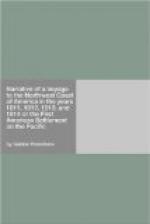[Footnote J: Mr. Thompson had no doubt been sent by the agents of the Northwest Company, to take possession of an eligible spot at the mouth of the Columbia, with a view of forestalling the plan of Mr. Astor. He would have been there before us, no doubt, but for the desertion of his men. The consequence of this step would have been his taking possession of the country, and displaying the British flag, as an emblem, of that possession and a guarantee of protection hereafter. He found himself too late, however, and the stars and stripes floating over Astoria. This note is not intended by the author as an after-thought: as the opinion it conveys was that which we all entertained at the time of that gentleman’s visit.]
The natives, who till then had surrounded us in great numbers, began to withdraw, and very soon we saw no more of them. At first we attributed their absence to the want of furs to trade with; but we soon learned that they acted in that manner from another motive. One of the secondary chiefs who had formed a friendship for Mr. R. Stuart, informed him, that seeing us reduced in number by the expedition lately sent off, they had formed the design of surprising us, to take our lives and plunder the post. We hastened, therefore, to put ourselves in the best possible state of defence. The dwelling house was raised, parallel to the warehouse; we cut a great quantity of pickets in the forest, and formed a square, with palisades in front and rear, of about 90 feet by 120; the warehouse, built on the edge of a ravine, formed one flank, the dwelling house and shops the other; with a little bastion at each angle north and south, on which were mounted four small cannon. The whole was finished in six days, and had a sufficiently formidable aspect to deter the Indians from attacking us; and for greater surety, we organized a guard for day and night.
Toward the end of the month, a large assemblage of Indians from the neighborhood of the straits Juan de Fuca, and Gray’s Harbor, formed a great camp on Baker’s Bay, for the ostensible object of fishing for sturgeon. It was bruited among these Indians that the Tonquin had been destroyed on the coast, and Mr. M’Kay (or the chief trader, as they called him) and all the crew, massacred by the natives. We did not give credence to this rumor. Some days after, other Indians from Gray’s Harbor, called Tchikeylis, confirmed what the first had narrated, and even gave us, as far as we could judge by the little we knew of their language, a very circumstantial detail of the affair, so that without wholly convincing us, it did not fail to make a painful impression on our minds, and keep us in an excited state of feeling as to the truth of the report. The Indians of the Bay looked fiercer and more warlike than those of our neighborhood; so we redoubled our vigilance, and performed a regular daily drill to accustom ourselves to the use of arms.




